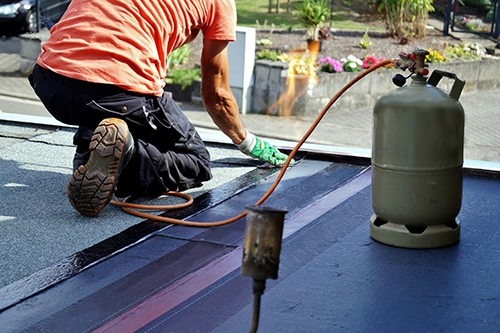- About Us
- Services
- Blog
- Contact
Need a quote?
Arranging a roof replacement in London might seem like a major task, but here at Environ Roofing we work hard to make life easier for our customers. That’s why we’re going to cover everything you need to know about roof replacement in London, in this blog.




While it’s often possible to repair a damaged roof, there are several circumstances in which it makes more sense just to replace the roof outright.
The first is major wear and tear. No roof is made to last forever and no matter how well you maintain it, sooner or later your roof is going to need replacing. Whilst a good roof can last for decades, and many houses have roofs dating back over fifty years that are still perfect today, there does come a point when it’s out with the old and in with the new.
The second sign it’s time for roof replacement is outdated materials. Whether due to environmental reasons or practical ones, sooner or later almost all construction materials become outdated. Roofing made from older materials is often far more prone to damage, requiring more regular replacement and driving up the cost of maintenance. If that’s the case with your roof, a full roof replacement might be a worthwhile investment.
At Environ Roofing, we offer a huge range of roofing services, covering just about everything you could need, including roof replacement in London.
One thing we really want to stress is that, when it comes to issues with your roof, delays can be expensive. In cases of serious damage, exposure to wind and rain can lead to other issues such as interior damage and even damp.
The second thing we want to stress is that we will always give our honest opinion about your roof. If we think repairs will tide you over, we’ll suggest that. We’ll only ever recommend complete roof replacement if it’s the only option.
If you’re not sure of the problem, a quick drone survey is the best way to find out. Our drone surveys provide accurate, high-resolution imagery, allowing us to identify potential issues quickly and effectively. This advanced approach minimises disruption and maximises accuracy, ensuring that your roofing assessment is thorough and reliable.
If you want to arrange a drone survey, or you’d just like to have a quick chat about your roof, get in touch with the Environ team.
It depends on the construction, but the minimum weight a flat roof must be capable of bearing is 300lbs. This refers to a concentrated weight where a load is positioned on just one area of the roof. So, for example, a commercial flat roof can approximately support a 300lb HVAC unit in a 2.5×2.5ft single space.
If you opt for a flat roof anywhere on your property, remember that it comes with a need for proper maintenance. Low-slope roofing London-wide should be checked every six months or so, or after spells of bad weather, to spot any signs of damage. No matter how small, these should be addressed before they escalate. Remove any debris (leaves, twigs and so on) regularly to avoid these blocking the gutters and allowing water to pool and stand on the roof.
If there are trees in the close vicinity, keep them cut back to reduce the amount of foliage that falls on your flat roof. And check internally for signs of moisture, dampness or water damage on a regular basis. Spotting problems early means resolving them will be cheaper in the long run.

Building a flat roof can be done in three ways. The simplest and most cost-effective choice for levelled roofing London-wide is to construct a warm roof where a roofing membrane is placed over the insulation that keeps the timber structure warm. Another option is to create a cold roof where insulation is positioned between the rafters under the ply roof covering. This is commonly applied to flat-roofed extensions.
The third method is the hybrid roof that contains diverse elements. Their designs require a gap of ventilation above a warm roof to prevent excess moisture within the roof structure.
If you’re looking for flat roofing local contractors, don’t just select the first firm you come across. Find a roofing company that’s been in business for a while and can demonstrate a good track record in installing, repairing, and replacing flat roofs specifically. Ask for recommendations from your own network or from a local trade association. If you need refurbishment work done to 50% or more of your roof, you’ll need a roofing contractor who can self-certify their work under the Competent Person Scheme. Otherwise, the Building Control department at your local authority will need to approve the job before it begins.
Ask whether they are covered by liability insurance and how long they’ll guarantee the work they will carry out. And never just opt for the cheapest quote unless you’re quite sure they’re the best company for the job. You can’t afford to compromise on your roof as the structural integrity of your property depends on it.
Ensuring your flat roof will comply with building regulations before installation can save property owners time, money and stress. First, the roof must have a slope of around 1:80, with water draining away to one or two roof edges. Waterproofing must be extended up to the adjacent walls with at least 150 mm from the surface of the roof.
Contractors must install ventilation in cold roofs. For warm roofs, the deck must be bonded with a VCL. The roof should have the capacity to withstand strong winds and be sturdy enough to take an individual’s weight. Finally, check whether planning permission is needed. Typically, this is only required if you live in a conservation area or a listed building, or are making significant changes to an existing roof.
If you’re looking for top roofing solutions at competitive rates, check out our range of roofing services at Environ Roofing Company London. To get started, call one of our representatives today!

